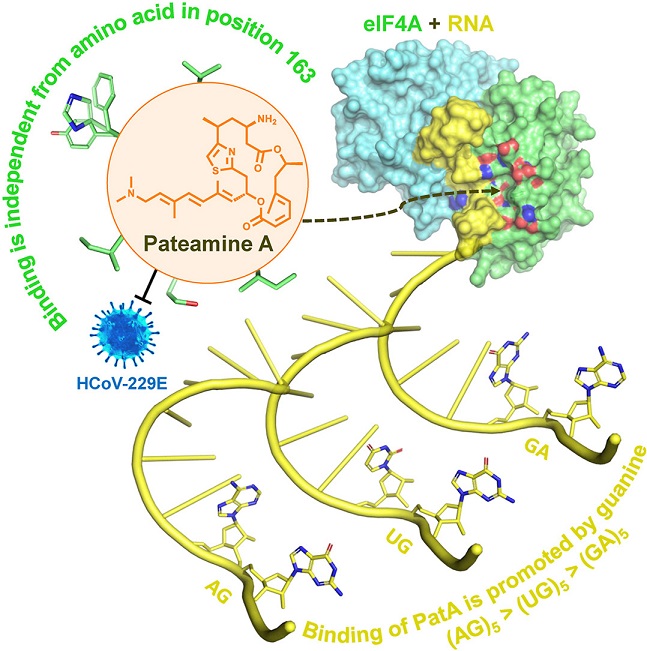Pateamines: New Antiviral Agents in the Fight Against Coronaviruses And Even Flu Viruses
Nikhil Prasad Fact checked by:Thailand Medical News Team Jun 24, 2024 9 months, 2 weeks, 6 days, 19 hours, 50 minutes ago
COVID-19 News: In the relentless quest to combat the persistent threat of coronaviruses, researchers have uncovered the powerful antiviral potential of pateamines, a group of compounds derived from the marine sponge Mycale hentscheli. These compounds have shown significant promise in blocking the replication of coronaviruses, including the human coronavirus 229E (HCoV-229E) and the infamous SARS-CoV-2. This discovery, covered in this
COVID-19 News report, could mark a significant advancement in our arsenal against viral infections.
 Graphical Abstract - Pateamines: A New Antiviral Agent in the Fight Against Coronaviruses And Even Flu Viruses.
What Are Pateamines?
Graphical Abstract - Pateamines: A New Antiviral Agent in the Fight Against Coronaviruses And Even Flu Viruses.
What Are Pateamines?
Pateamines are marine macrodiolides that inhibit the RNA helicase eIF4A, an
enzyme crucial for the translation of viral proteins. By blocking this enzyme, pateamines effectively prevent the virus from replicating and spreading within the host. The study, conducted by an international team of scientists, revealed that pateamines clamp RNA onto the surface of eIF4A, thereby inhibiting the enzyme's activity and disrupting viral protein synthesis.
How Pateamines Work
The eIF4A enzyme plays a pivotal role in unwinding stable RNA structures within the untranslated regions of mRNAs, which is essential for the initiation of protein synthesis. Pateamines disrupt this process by binding to the RNA-eIF4A complex, preventing the unwinding step necessary for viral replication. Unlike other compounds that target the same enzyme, pateamines do not rely on specific sequences in the RNA for effective binding, making them versatile in their antiviral action.
The Study's Findings
The research team, which included German scientists from Philipps University Marburg, Justus Liebig University Giessen, and the Max-Planck-Institut für Kohlenforschung, among others, conducted detailed analyses of pateamines' binding behavior and antiviral activity. They discovered that pateamines show potent antiviral effects at low nanomolar concentrations, making them highly effective even at minimal doses.
Detailed Analysis
The researchers used a variety of techniques to analyze the binding mode of pateamines. One of the key methods was the Thermal Shift Assay (TSA), which measures changes in the stability of the eIF4A-RNA complex upon binding of the inhibitor. The results showed that pateamines have a less restrictive binding mode compared to other inhibitors like rocaglates. This means pateamines can effectively bind and inhibit eIF4A even in the presence of mutations that render other inhibitors ineffective.
Additionally, the study highlighted that pateamines do not depend on a specific polypurine tract in the RNA substrate for efficient RNA clamping. This was a significant finding because it demonstrated that pateamines could be effective against a broader range of RNA sequences, increasing their potential antiviral spectrum.
/>
Broad-Spectrum Antiviral Potential
One of the most exciting aspects of pateamines is their broad-spectrum antiviral potential. In addition to combating coronaviruses, pateamines have shown activity against other viruses that depend on the eIF4A enzyme for protein synthesis. This includes viruses like the Zika virus, Influenza A, and even certain pathogenic protozoa. This wide-ranging effectiveness makes pateamines a promising candidate for developing treatments against a variety of viral infections.
A New Tool in Our Arsenal
The discovery of pateamines as potent antiviral agents is a significant breakthrough. Their ability to inhibit eIF4A and disrupt viral replication without relying on specific RNA sequences sets them apart from other antiviral compounds. This unique mode of action broadens our toolkit in the fight against viruses, providing a potential new strategy for treating current and emerging viral threats.
Moving Forward: Clinical Implications
While the findings are promising, further research is necessary to fully understand the potential of pateamines in clinical settings. The researchers emphasize the importance of evaluating the safety and efficacy of these compounds in vivo (within living organisms) to ensure they are safe for human use. Additionally, exploring different methods of administration, such as topical or aerosol applications, could help minimize potential side effects and maximize the antiviral benefits.
Safety and Efficacy
Initial tests have shown that pateamines have a relatively low cytotoxicity in human fetal lung fibroblasts (MRC-5 cells), which are commonly used as a model system for studying coronaviral infections. This is an encouraging sign, as it suggests that pateamines could potentially be used in treatments without causing significant harm to healthy human cells.
Potential Application Methods
Considering the potent antiviral activity of pateamines, researchers are exploring various methods of administration. Topical or aerosol applications are being considered to reduce potential toxic side effects and bypass the first-pass effect of the liver. These methods could allow the drug to target the respiratory system directly, where coronaviruses primarily infect, enhancing its efficacy while minimizing systemic exposure.
Future Research Directions
The discovery of pateamines' antiviral properties opens up several avenues for future research. Scientists are now focused on further understanding the detailed mechanisms by which pateamines inhibit eIF4A and exploring their efficacy against other viral pathogens. Additionally, preclinical studies will be crucial to assess the safety, optimal dosing, and administration routes for potential therapeutic use in humans.
Conclusion
The potent antiviral activity of pateamines against coronaviruses and other viruses offers a glimmer of hope in the ongoing battle against viral infections. As research continues, these marine-derived compounds could become a cornerstone in the development of new antiviral therapies, potentially saving countless lives and providing a robust defense against future pandemics.
The study findings were published in the peer reviewed journal: Heliyon.
https://www.sciencedirect.com/science/article/pii/S2405844024094404
For the latest COVID-19 News, keep on logging to Thailand Medical News.
Read Also:
https://www.thailandmedical.news/news/breaking-university-of-maryland-study-finds-that-pyronaridine-tetraphosphate-is-an-effective-antiviral-against-all-coronaviruses-and-sars-cov-2-varian
https://www.thailandmedical.news/news/lactoferrin-an-iron-binding-protein-with-antiviral-and-antibacterial-properties
https://www.thailandmedical.news/news/herbs-and-phytochemicals-antiviral-properties-of-milk-thistle
